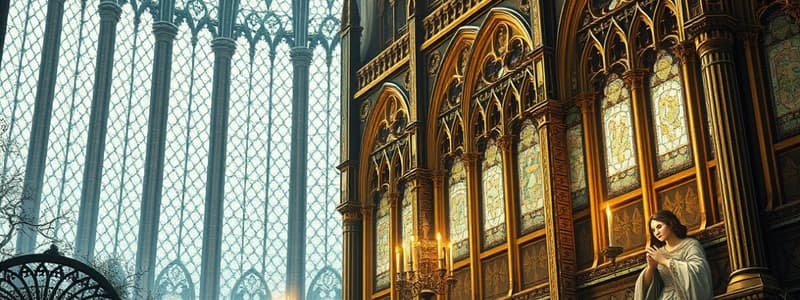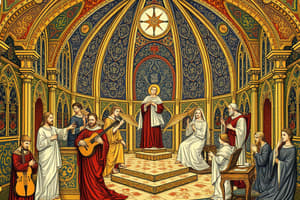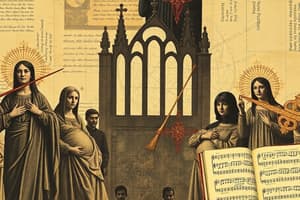Podcast
Questions and Answers
Gregorian Chant is characterized by polyphonic texture.
Gregorian Chant is characterized by polyphonic texture.
False (B)
What is another name for the Medieval Period?
What is another name for the Medieval Period?
Middle Ages or Dark Ages
What type of music did Pope Gregory create?
What type of music did Pope Gregory create?
- Baroque Music
- Renaissance Music
- Gregorian Chant (correct)
- Medieval Folk Music
Match the characteristics of Gregorian Chant with their descriptions:
Match the characteristics of Gregorian Chant with their descriptions:
Which of the following is a characteristic of Gregorian Chant?
Which of the following is a characteristic of Gregorian Chant?
What notation system was used in Gregorian Chant?
What notation system was used in Gregorian Chant?
What is Troubadour music?
What is Troubadour music?
Who performed Troubadour music across Europe?
Who performed Troubadour music across Europe?
Secular music was primarily religious and followed Catholic traditions.
Secular music was primarily religious and followed Catholic traditions.
Flashcards are hidden until you start studying
Study Notes
Music of Renaissance and Baroque Periods
- The Medieval Period, also called the Middle Ages or Dark Ages, spans from 700 to 1400.
- This era began following the fall of the Roman Empire, marking a significant cultural shift.
Types of Medieval Music
- There are two primary categories of music from the Medieval Period.
Gregorian Chant
- Developed under Pope Gregory, establishing this form of music as central to Catholic worship.
- Recognized as the officially sanctioned music of the Catholic Church during the Medieval Period.
Characteristics of Gregorian Chant
- Monophonic Texture: Consists of a single melodic line without harmony.
- Free Meter: Lacks a regular rhythmic structure, allowing for expressive performance.
- Modal Use: Based on modes rather than the traditional major and minor scales.
- Latin Liturgy: Texts are performed in Latin, aligning with the language of the Church.
- Neume Notation: Early system of musical notation used to indicate pitch and phrasing.
Troubadour Music Overview
- Emerged in the latter part of the Medieval period, marking a shift in musical expression.
- Characterized as secular music, which means it is independent of Catholic religious traditions.
Key Players
- Troubadours were a group of musicians crucial in the performance and spread of this music throughout Europe.
- Their performances contributed to the cultural exchange and evolution of music during this era.
Studying That Suits You
Use AI to generate personalized quizzes and flashcards to suit your learning preferences.




